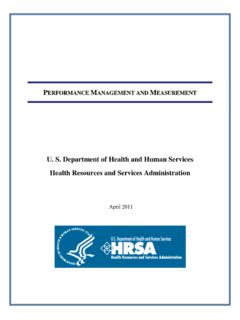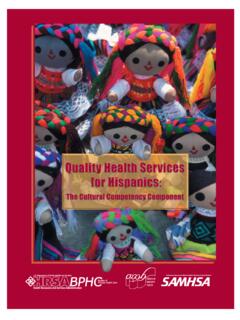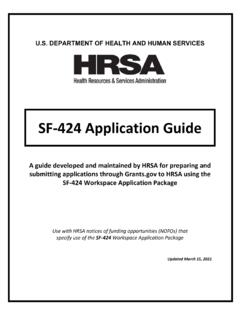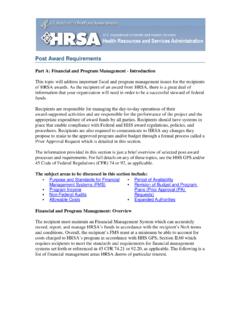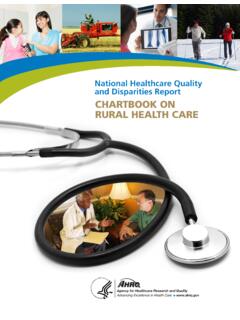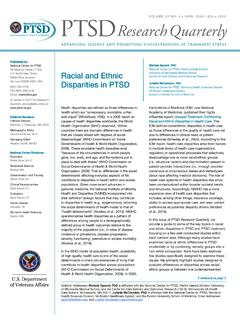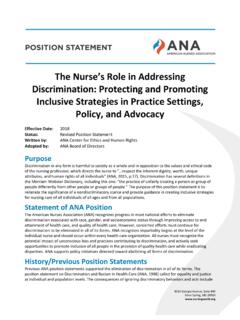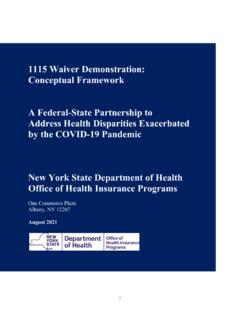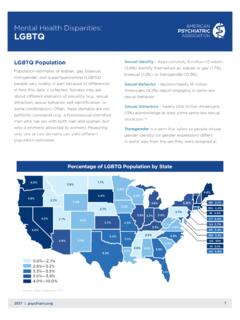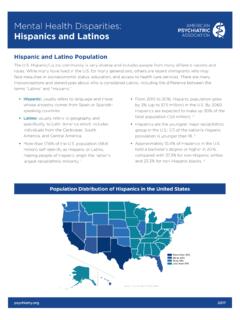Transcription of Rural Disparities in Access to Care - Health Resources and ...
1 Rural Health Policy Brief 1 Special Needs in Rural America: Implications for Healthcare Workforce Education, Training, and Practice COGME Council on Graduate Medical Education July 2020 Rural Health Disparities Almost 60 million people, or one in five Americans live in a Rural While Rural communities have many inherent strengths and support a high quality of life,2 Rural residents experience significantly worse Health outcomes than their urban counterparts. Compared to those living in urban areas, Rural residents have higher rates of mortality from heart disease, respiratory disease, cancer, stroke, and unintentional injury which are the five leading causes of death in the ; higher maternal and infant mortality4; and higher rates of death by Overall, Rural populations are older and sicker than those in urban areas, and face an increasing gap in life expectancy.
2 These Disparities are increasing over ,6 Public Health emergencies like the coronavirus disease COVID-19 pandemic will further exacerbate these disparities7 [see Brief Statement, page 2]. At the heart of many Rural -urban Health Disparities is the lack of Access to quality Health care . Rural communities often lack basic Health care facilities, and Rural residents face chronic shortages of doctors, nurses, pharmacists, and non-physician Overview: Rural populations face increasing Disparities in many Health outcomes and a significant gap in life expectancy, compared to urban populations. At the heart of these Disparities is a lack of Access to Health care , which can be exacerbated by a public Health emergency like the coronavirus disease (COVID-19) pandemic. Many Rural areas have a shortage of Health care providers and lack a hospital or similar facility.
3 Many Rural hospitals have closed or are at financial risk of closure, which further impairs the local Health care workforce. However, the Health care system as a whole is shifting away from acute hospital care and toward care provided in community- or home-based settings. Rural communities need to assess their Health care needs and the available workforce and facilities, while providers in Rural areas must be flexible in addressing the wide-ranging needs of their patient population. Combating the nation s Rural Health challenges requires a redesign of the investments in Rural Health workforce training to place patients, their families, and their community needs at the center of policy interventions. The Council on Graduate Medical Education (COGME) provides a series of three Rural Health Policy Issue Briefs, with recommendations to strengthen Rural Health workforce training and improve Access to Health care in Rural communities.
4 The recommendations address the Health and social care needs of Rural America through evidence-based, patient- and community-centered Health workforce investments spanning education, training, and practice. COGME Rural Health Issue Brief #1 Page | 2 Updated July 17, 2020 The Health care landscape is changing rapidly. New Health and payment incentives are shifting care to outpatient, community, and home settings. The shift from fee-for-service to value-based payments places greater emphasis on ambulatory care provided in community- and home-based settings. Combating the nation s Rural Health challenges in the context of rapid Health system change requires radically redesigning the way we invest in the Rural Health workforce to place patients, their families, and their community needs at the center of policy Recognizing the changing needs of Rural America, the Council on Graduate Medical Education (COGME) provides a series of recommendations to strengthen Rural Health workforce training and improve Access to Health care in Rural communities.
5 The recommendations address the Health and social care needs of Rural America through evidence-based, patient- and community-centered Health workforce investments spanning education, training, and practice. Rural Disparities in Access to care At the heart of many Rural -urban Health Disparities is the lack of Access to quality Health care . Of the roughly 2,000 counties classified as Rural , more than 170 lacked an in-county critical Access hospital, Federally Qualified Health Center, or Rural Health clinic, collectively known as safety-net As a result, travel to the nearest hospital or clinic can take over an The problem of Health care Access is also worsening, as the rate of Rural hospital closures has accelerated in the last 10 years, further reducing Access to emergency care and other Health By some estimates, more than half of all Rural counties in the United States lack a single local hospital where a pregnant woman can get prenatal or labor and delivery ,14 Even when the necessary facilities do exist, they are frequently understaffed and suffer from Health workforce shortages.
6 According to the latest data from the Health Resources and Services Brief Statement on COVID-19 and Rural Health care As COGME was preparing this set of issue briefs on Rural Health care , the nation began to experience the COVID-19 pandemic. A national public Health emergency will likely exacerbate the Health care Access gaps between Rural and urban areas. Rural hospitals and Health systems will not have the capacity to respond on their own, and will likely need substantial federal assistance, at least until a vaccine can be developed or an effective treatment devised. Initial steps in the federal response are working to: ease restrictions on the use of telehealth, expand the Health care workforce by facilitating theentry of recent graduates and the re-entry of retirees, encourage states to allow all members of the healthcare team to work to their full scope of practice.
7 COGME appreciates the efforts of all who are called to respond to caring for COVID-19 patients, maintaining the Health system to respond to all persons in need of care , and reducing or preventing the spread of this and other diseases. Lessons learned during this crisis will help inform COGME s recommendations to strengthen Rural Health care Access and improve Rural Health Rural Health Issue Brief #1 Page | 3 Updated July 17, 2020 Administration, in March 2020 almost 70% of areas designated as primary medical Health professional shortage areas were Rural or partially Rural Rural hospital closures are associated with long-term decreases in the supply of physicians in multiple specialties, including primary care physicians, medical specialists and With fewer Health care professionals available, clinical practice in Rural areas demands the generalist skills of a primary care provider who can treat patients with a wide range of complex physical and behavioral Health needs.
8 Because the Rural workforce is interdependent and interprofessional, shortages among one profession or specialty have a domino effect on others. For example, general surgeons are essential to the provision of full-service medical care . Lack of Access to a general surgeon as backup limits other hospital services such as trauma care , oncology treatment, and colonoscopies. This interdependence is not limited to general surgeons. Recent reports have highlighted declining Access to maternity care in Rural communities, in part because hospitals face chronic shortages of maternity- care providers such as family physicians, obstetricians, certified nurse midwives, and labor and delivery nurses, as well as surgeons and anesthesiology ,18 Primary care workforce shortages and difficulty accessing needed specialty services result in unnecessary trips to the emergency room, which further exacerbate the strain on hospitals that are already underfunded and Rural Health Workforce: The Demand-Capacity Mismatch Current investments in workforce training are not adequately addressing Rural Health Disparities or bolstering our Rural Health workforce.
9 The nation spends significant taxpayer dollars on workforce training $ billion alone on graduate medical education for physicians but the workforce remains maldistributed by specialty, geography and setting. Efforts to better distribute funding to meet Rural Health workforce needs have been unsuccessful despite the fact that residency location is a known predictor of a physician s future practice location. One study showed that 56% of family medicine residents practice within 100 miles of where they completed their ,21 The Government Accountability Office estimates that only 1% of residents train in Rural And while care is shifting from hospital to ambulatory settings, most GME funding still goes to hospitals in urban settings. A focus on patients and populations instead of individual provider groups is needed to redefine the crisis from a shortage to a demand-capacity mismatch that could be addressed by investing in team-based models of care that integrate behavioral, social, and community services.
10 Primary care capacity, COGME Rural Health Issue Brief #1 Page | 4 Updated July 17, 2020 for example, can be greatly increased by empowering licensed personnel, including registered nurses and pharmacists, to provide more care , as well as by allowing medical assistants to function as panel managers and Health coaches to address many preventive and chronic care needs. Primary care settings have increasingly become a gateway for many individuals with behavioral Health needs this means, for example, that social workers play an important role in primary care ,23 serving as: Behavioral Health specialists: providing clinical interventions for behavioral Health andsubstance use disorders Case managers: coordinating, monitoring, and assessing treatment plans Navigators: connecting patients with community Resources for transportation, food, housing,employment, Spots for Rural Health While addressing persistent workforce shortages in Rural communities may seem an intractable problem, significant momentum exists.
